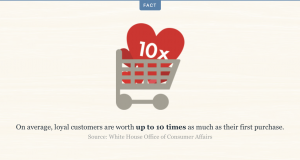Want to learn about other marketing goals than just the most obvious ones?
We all have dreams of things we want to do and achieve. As a brand, you dream of building an empire or impacting as many lives as possible. But a dream is just a dream – a vague idea of what the future should look like. But when you clearly define that dream and put actions into play that will help you reach your dream, it becomes a goal.
And all of a sudden, that huge dream isn’t too far away, because you know exactly what you need to do to get there, and that it is possible. You put one foot in front of the other and you start progressing.
In other words, different from dreams, goals are clear and specific and include a plan of how they’re going to be achieved.
You’ve probably heard a million times that goals are crucial for success.
But that’s because there’s actually a ton of truth to that.
Your goals are like your roadmap which tell you which route you’re going to take
If you don’t have goals, you’ll either stand still at the crossroad not knowing which way you should go or, you’ll just take a road which may not lead you to where you want to go.
Two crucial parts of marketing include having marketing goals and then evaluating and measuring the results of your efforts.
And the fact of the matter is that your goals and your result measuring are integrated with each other, because if you aren’t set marketing goals, it will be difficult to know what you are going to measure, and if you aren’t measuring, you won’t know what needs to be changed, what works, and what doesn’t.
But a big marketing challenge that marketers face is not knowing what goals they are going to have.
Chances are, that’s why you’re here.
The fact of the matter is that there is a whole array of marketing goals that you can choose from, as you’ll discover in this list of marketing goals, but choosing to work towards too many at once will only result in you spreading yourself short.
Therefore, you need to identify which marketing goals are most important for you, nail them into your marketing strategy, and then work to achieve them.
But just choosing some marketing goals isn’t everything, though. You need to select marketing objectives that support your business objectives, and here’s where many people struggle.
Don’t worry, though. It doesn’t have to be that difficult.
In this article, I’ll be sharing a complete list of marketing goals, explain them, and help you decide which marketing goals you should be focusing on.
Why set marketing goals?
It’s safe to say that goals are part of all successful businesses and humans.
If you don’t have dreams, you’re operating in the blind, and doing things that you hope will take you to where you want to go, rather than identifying what needs to be done to get to where you want to go.
Setting marketing goals puts what you want to achieve on paper, and gives you a concrete idea of how that goal can become a reality. In other words, it takes a dream and makes it into something concrete and attainable.
Setting both short-term and long-term goals are crucial parts of all successful businesses’ marketing strategies, and they allow the whole team to cooperate, to faster and more effectively reach the marketing goals.
One might say that marketing goals are the foundation for business success.
Setting marketing goals according to the SMART formula
You’re probably familiar with the SMART formula of setting goals, and since marketing goals are goals too, it can be applied here as well.
Marketing goals are great because they tell you what you need to do to achieve wanted results, but to be effective, they need to follow the SMART formula.
SMART stands for:
- Specific
- Measurable
- Achievable
- Realistic
- Time-bound
Following this allows you to set marketing goals that are clear, understandable, specific, relevant, and measurable.
Now, there are plenty of marketing goals that really aren’t goals, and by following this formula, you are able to identify the goals that are relevant and truly matter to your brand.
Something that separates dreams from goals is that goals are time-bound. Saying ”one day I am going to become a multimillion dollar company” is a lot different from saying ”In one year, we’re going to become a multi-million dollar company and here’s how we’re going to do it”.
All goals, including marketing goals, can be categorized into short-term and long-term goals.
And all that’s saying is the time in which you’re going to reach your marketing goal.
Together with that obviously comes a sprinkle of ”realism”, as you saw in the SMART formula because it’s obviously not possible to become a billion-dollar corporate in one week if you’ve just started out, right?
Short-term goals are goals that can be worked towards, and achieved, within days or weeks.
Long-term goals, however, are marketing goals that you are meant to achieve within months or even several years.
When setting marketing goals, it is crucial that you have set short- and long-term goals. Because often times, your short-term goals will support your long-term goals. And often, a marketing goal can be both short-term and long-term, which you’ll see in the list of marketing goals. The difference, in these cases, however, is the way they play out in practice.
Short-term marketing goals are more focused on the day-to-day and weekly activities which will help you get you where you want to go, whereas, with the long-term goals, it is the small, consistent efforts and actions that will ultimately get you to where you want to go on a macro.
As such, you can expect that short-term goals are much more actionable than long-term goals.
Your short-term goals should be things that support your end goal of achieving marketing results. For example, the marketing goal of gaining 100K followers on social media will, in theory, mean absolutely nothing to you, but it is what having 100K followers resembles and mean that is important, as it means you’re able to reach more people, and thus maybe support your long-term goal of building a multi-million dollar brand.
Many marketing goals can be both short-term and long-term, but there will still be key differences between them.
For example, my short-term goal might be to increase sales, and my long-term goal might be equally so. But my long-term goal might be to sell 1 million units, whereas my short-term goal might be to break the record of sold units per month. And if the short-term marketing goal of sold units per months isn’t reached, I won’t reach my long-term goal either.
In that way, you can see that short-term and long-term goals are dependent on each other.
It got a little more practical than I intended, and maybe a bit complicated, but it was necessary for when we dig into the list of marketing goals which we’re going to do right now.
List of marketing goals: Short-term
Increase sales
Increasing sales is obviously a marketing goal which can be both short and long-term. You might, for example, have a huge long-term goal of increasing your sales immensely within a few years, but this is obviously only possible if you’re increasing your sales in the short-term, too.
In other words, the long-term goal is highly dependent on the short-term goal. The marketing goal of increasing sales is self-explanatory and essentially means that you’re setting the marketing goal to sell more products, physical or non-physical, and according to the SMART goal-setting formula making that goal specific, for example, sell 1000 products a month, or sell products for $100,000 per month.
Launch new products/services
A marketing goal doesn’t always have to be things you want to achieve in a marketing result sense. Remember that your products and brand are the centers of your marketing strategy, and it is those two things that you’re marketing when you’re working to get your brand out there.
Often times, the marketing goals are dependent on this specific goal.
For example, if I am a car manufacturer and my goal is to increase sales by entering new markets, I obviously need to launch a right-hand driven car if I am trying to get into the British market to help support that goal.
Launching new products/services, or improving the ones that already exist are crucial parts of gaining a bigger market share and thus increasing revenue because if you don’t have products that speak to your audience, you’ll never be able to convert them to customers. However, by launching new products or services, you are able to do so, and in that way, it’s clear that this is a short-term marketing goal which supports your long-term goals.
Reach and acquire new customers
This is an example of a marketing goal that can be both short-term and long-term.
By reaching and acquiring new customers, you can increase your revenue as well as market share, but in order to reach new customers, you have to do several different things to speak to the audience you’re trying to reach.
You might, for example, have to develop a new product, you might need to create marketing campaigns, and you might have to establish new locations internationally.
For the vast majority of brands, reaching and acquiring new customers is a crucial part of their marketing goals, because, without customers, there won’t be a successful business. The place where it may differ between brands, might, however, be the way you approach the marketing goal of acquiring new customers because it can be done in a number of different ways.
Improve customer relationships
This is yet another marketing goal that can be both short-term and long-term, but most often, it is both.
The way you improve your customer relationships isn’t on a macro, but it is on a very micro-level where each customer interaction counts.
Sure, on a macro level, your goal might be to improve your customer relationships, but most of the actions in getting there are very micro.
There are obviously several approaches to improving customer relationships, but the way you build relationships with someone is by interacting with them, right?
And you don’t build relationships after just one or two interactions.
Just think about how many interactions you’ve had with your best friend to get the strong relationship you have today.
The main reason you want to improve customer relationships is that it leads to trust. And if your customers don’t trust you, they won’t buy from you.
Moreover, trust also lead to customer loyalty, and thus customer retention. And customer retention is a long-term marketing goal that I’ll go more into detail on further on.
Since improved customer relationships are mainly built as a result of the consistent and regular interaction, when you’re working towards this marketing goal, you need to focus on how you can get in touch with your customers, and how you can engage and interact with them on a regular basis. Because strong relationships aren’t built after one interaction.
Brand Engagement
Brand engagement is a marketing goal which means increasing the rate of interaction with your customers. And since brand engagement is focused on getting your customers to engage with your brand, the way it is achieved and worked towards is by first taking the step in interacting with them.
In that sense, the marketing goal of brand engagement is very similar to the approach of improving customer relationships, and the simple reason for that is that improved customer relationships lead to brand engagement and customer loyalty.
Of course, measuring brand engagement can be quite tricky, but it is not, however, tricky to see if it’s going in the right direction.
Customer Satisfaction
Customer satisfaction is a marketing goal which can be both short and long-term, and this is the reason why it’s listed on both.
Customer satisfaction is a common marketing goal for customer service, and that’s because the satisfaction of the customer is most often highly dependent on how they feel.
In fact, a study found that 70% of buying experiences are based on how the customer feels they are being treated.

This means that by increasing customer satisfaction, you can also work towards your marketing goal of increasing sales and increasing revenue, which is two goals that most brands have.
This marketing goal is also one that supports a lot of other goals, too, because if you have loyal customers, the chance is, you’ll have a much higher retention rate, because many times, the reason customers leave a brand is that that they are disgruntled for not being treated the way they deserve.
Customer Ratings
Customer ratings are an obvious short-term marketing goal, but one that supports your long-term goals, too.
Good customer ratings are dependent on how satisfied your customers are with your brand and customer service, and in that way, customer ratings come as a result of good customer satisfaction.

The best part about this marketing goal is that it is easily measured.
If your customers are leaving great customer ratings, it’s because they have received great customer service, and that they are satisfied.
Units sold
Units sold can be both short and long-term, but when it comes to setting the marketing goal of selling X number of units, it’s often focused on a shorter period of time. For example, you might set the goal of selling X number of units during the Christmas month, etc.
It’s impossible to get away from the fact that more units sold also mean more revenue, and therefore, making units sold into a micro will support your revenue or sales goal on a macro.
List of marketing goals: long-term
Enter new markets
This is a marketing goal which can be both short-term and long-term. Marketing goals are most often part of the long-term strategy, though, because it supports the long-term vision of increasing market share and increasing revenue and sales.
If you’re in a competitive market, or if you’ve already conquered a specific market, you need to widen your net to reach prospects where they are, and a part of that is most often to enter new markets.
Brand Awareness
Brand awareness is a typical long-term marketing goal, and the reason is that it is impossible or at least very difficult to build noticeable brand-awareness in a short period of time.
Brand awareness refers to the number of people who know your brand and how well it is known to your target audience, as well as how well it is known compared to your competitors.
The more your business grows, the better brand-awareness you’ll obviously get because to get someone to buy from you, they first need to become aware of your brand’s existence.
Brand-awareness is crucial for expansion because getting significant brand-awareness will mean that your brand will become the first brand people think of when they think about your industry.
For example, if I ask you to mention a luxury watch brand, chances are, you’ll say Rolex.
That’s because they’ve focused so much on building their brand-awareness and become a brand that everyone knows of.
The reason?
When and if you ever consider buying a luxury watch, Rolex will probably be at the very top of your mind since it will feel familiar, and it might just be the only brand you know.
Brand awareness is, however, built as a result of short-term actions.
Everything you do in marketing to make people aware of your brand supports your marketing goal of increasing brand awareness. This can be actioned as simple as getting featured in the newspaper or just reaching a new prospect through a post on social media.
Reputation
Reputation is a marketing goal that is almost solely a long-term goal, as it depends on your long-term thinking and execution.
For example, you might stand in front of a dilemma where you have the opportunity to either make more money in the short-term by not including tissue paper in your shoebox or, make less money by including the tissue paper in the box.
In the short-term, the choice is obvious.
Make more money, right?
But that small detail of including tissue paper in your box might significantly improve the emotions your customers have when they unbox your product and make them more proud of using your product due to the sense of exclusivity they felt when unboxing it.
Now, on a micro level, that tissue paper resulted in you making less money, but what including tissue paper will mean is it will significantly improve your brand’s reputation on a macro level, and in the long run, small details like that will lead to more sales.
Reputation is the way you establish yourself as a brand, and how your customers view you, and everything you do will affect your reputation, even down to the smallest details of including or not including tissue paper in your box.
The reputation you want to establish for your brand should be aligned with the way you want your customers to feel when they use and buy your products, and thus also be decided based on the target audience you have.
For example, if you are targeting teens, a good idea is probably to build the brand reputation of being cool and trendy, but fora brand like Rolex, it is to build a reputation of exclusivity, luxury, and superior quality.
Customer Relationships
I’ve already spoken about customer relationships in the form of being a short-term marketing goal, however, improved customer relationships can also be a long-term marketing goal.
Reputation is in a way integrated with your customer relationships, as the reputation your brand has will have an impact on your customers’ relationship with your brand.
Now, interacting with your customers one-by-one is the single most important way to building customer relationships, and this is obviously done as a result of short-term execution, but at the same time, those small consistent actions help support your long-term goal.

The best part about improved customer relationships is that they lead to increased customer loyalty and increased customer retention.
Why is this relevant?
Because a study found that on average, loyal customers are worth up to 10 times as much as their first purchase. And moreover, the probability of selling to an existing customer is 60-70% whereas the probability of selling to a new customer is only 5-20%.
This means that focusing on improving customer relationships as a part of your long-term marketing goals will ultimately help support your long-term goal of increasing your revenue.
Margins
Improving your margins is a form of long-term marketing goal, and essentially, it means that you increase the profit you make per sold unit. You can do this in two ways:
Increase the price of your product, or decrease the cost of producing your product.
Increasing your margins will not necessarily increase your revenue, but what it can do, however, is increase your profit.
Now, you never want to improve margins by compromising on quality, but the most common ways to increase margins is by streamlining the process of production.
Market Share
Market share refers to how big of a market your brand has in your industry, compared to your competitors.
Increasing market share means stealing/winning market share from your competitors, and doing so means increasing revenue and sales by increasing your number of customers.
To gain market share, you need to give people a reason to become customers of your brand rather than your competitors.
This means that you need to create a value proposition that is better than your competitors’ because people who are customers of a brand are generally hard to convert unless they’re really unsatisfied with the brand they’re buying from.
This can be a better price, better product, or better service.
Product quality
Improving the product quality is often the marketing goal of brands.
Improving the quality means improving your value proposition, and giving your customers a better experience by giving them more for their money. This, in the end, can contribute to more sales.
Increase Revenue
Most brands have the goal of increasing revenue.
And that is because of the simple reason that increased revenue means growth, and it means the opportunity of continued growth.
There are endless of ways you can reach increased revenue, but a fundamental part is obviously acquiring customers and driving sales. And the way you do this is through marketing efforts, small or large, which supports the end goal.
Increase Credibility
A marketing goal of brands is often to increase credibility.
Once you get your customers to know about you, you need to focus on increasing their trust in your brand. The more credibility you have, the more trustworthy you’ll be, and the easier it will be to convert your audience into customers.
Moreover, an increased credibility means that more customers will come to you, as well a start seeing you as an industry expert.
Customer Retention
Customer retention is extremely valuable as a brand, and you saw proof of that in the statistics I presented earlier, with returning customers being worth considerably more than new customers.

The best part is that it is a lot cheaper to get people to buy from you again than it is to get new people to buy from you, and the way you do this is often through improved customer relationships and customer loyalty.
Customer Lifetime Value
Increasing the customer lifetime value means increasing the lifetime of a customer of your brand. Since customer loyalty means customers that spend more, and that it is cheaper to convert existing customer, this is another approach to increasing revenue, but by not acquiring new customers.
The bottom line…?
The bottom line is that there are a lot of marketing goals and things that you can strive towards as a brand. Obviously, they are far too many to have as goals all at the same time, but there’s nothing that’s stopping you from changing your objectives and marketing goals as you’re developing new marketing strategies and tactics.
What you need to think about, however, is that you don’t jump from objective to objective after just a short while. Long-term goals are just that, long-term, and that means that you need to work on them long-term as well.
Which are your focus marketing objectives?
Let me know in the comments below!


